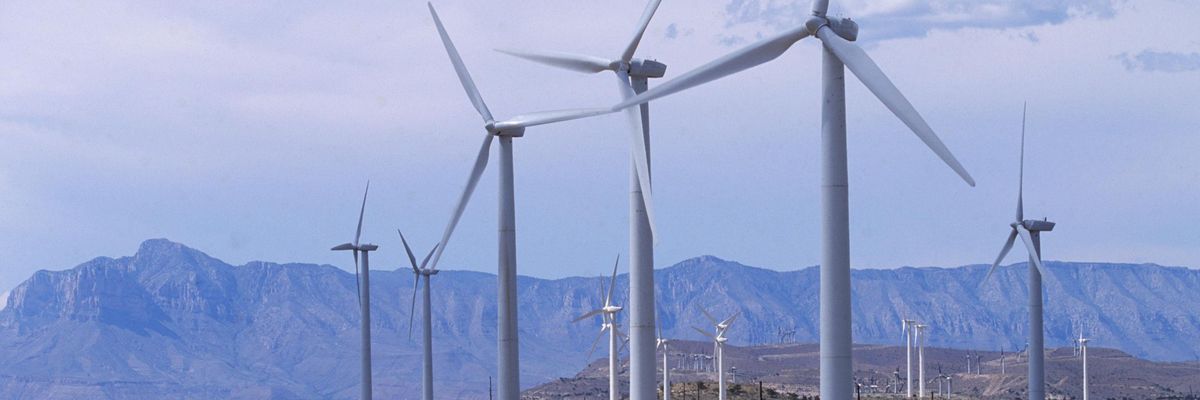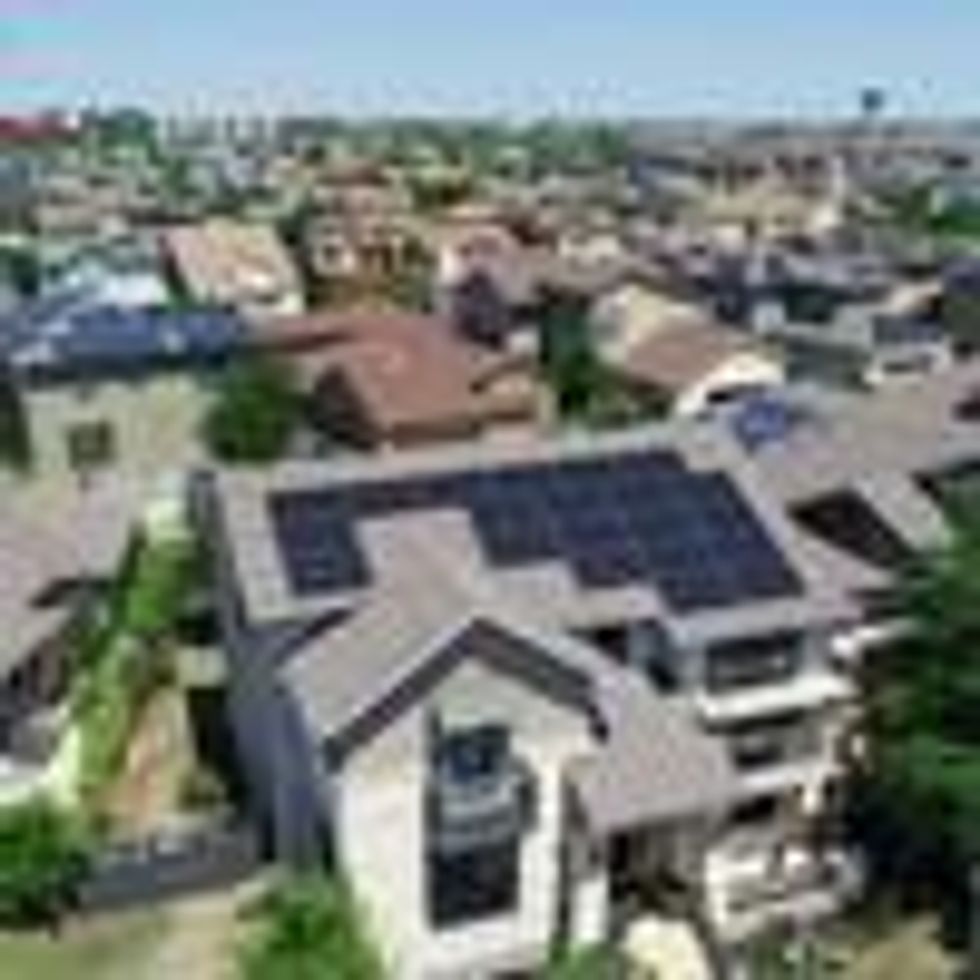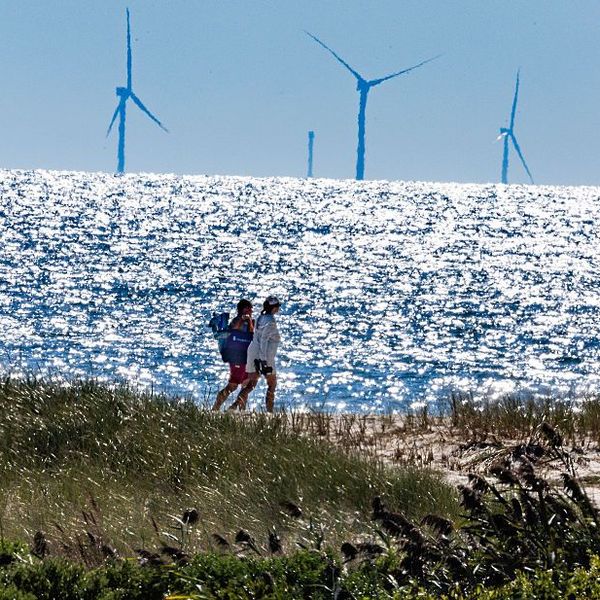
The Delaware Mountain Wind Farm is located in Culberson County, Texas. (Photo: Greg Smith/CORBIS/Corbis via Getty Images)
Can Texas Ditch Coal? Easily, Study Says, With Wind and Solar
"Cleaning up the energy that we use to power society is one of the most important things we need to do."
New research out of Texas reveals how wind and solar can replace coal power across the state and serve as a "model for the nation" amid mounting scientific warnings about the necessity of keeping fossil fuels in the ground and shifting to renewable energy.
"Simply put, it's not always windy and not always sunny, but it's almost always windy or sunny somewhere in Texas."
Published in the journal Renewables: Wind, Water, and Solar, the research was conducted by Rice University engineers--including associate professor Daniel Cohan, who said Monday that "this paper is really about how we can transition away from coal as quickly as possible."
"Texas still burns more coal and emits more sulfur dioxide and other pollution than any other state," the environmental engineer noted. "Even though a transition is inevitable, it's urgent that we move off coal as quickly as possible to improve air quality and health."
Co-author Richard Morse warned that "cleaning up the energy that we use to power society is one of the most important things we need to do."
Texas is unlike any other U.S. state when it comes to its power system. As the paper details:
Most of the state's power grid is managed by the Electric Reliability Council of Texas (ERCOT), which has only limited connectivity with other power grids in the United States and Mexico. Thus, any decline in fossil fuel generation in ERCOT must be replaced primarily with alternative sources of power within its domain. In 2019, the generation mix in ERCOT was 47% natural gas, 20% coal, 20% wind, 11% nuclear, and 2% solar, and other sources. Developers have proposed hundreds of new wind and solar farms, but ERCOT's 2025 capacity and demand report forecasts that far fewer will be built. ERCOT drew national attention during winter storm Uri in February 2021, when outages at natural gas, coal, wind, and nuclear plants caused widespread blackouts.
The 2021 storm has fueled growing calls to step up the clean energy transition in Texas--a state dominated by GOP policymakers. A report published last month, for example, showed how rooftop solar power could have helped save lives during last year's deadly crisis.
Related Content

Analysis Shows How Rooftop Solar Could Have Saved Lives During Texas Deep Freeze
The new paper from Cohan and his co-authors, which builds on research from 2018, focuses on "the potential for new wind and solar projects already proposed in the ERCOT interconnection queue as of June 2020 to replace the coal power that remained in 2019."
The team found that "a mere subset of wind and solar projects already in the interconnection queue are sufficient to replace all the output from those plants under two key conditions--adequate transmission, and reliable and flexible operation of existing resources."
"Simply put, it's not always windy and not always sunny, but it's almost always windy or sunny somewhere in Texas," the paper says. The experts emphasize the importance of transmission lines connecting cities to windy and sunny regions of the state.
"By not connecting to other grids, Texas has missed out on opportunities to sell surplus wind and solar power to other states."
"In Texas, that's the biggest bottleneck slowing the growth of wind and solar," said Cohan. "The bipartisan infrastructure bill that passed last year is a good start, but doesn't have nearly enough funding for transmission. Also, by not connecting to other grids, Texas has missed out on opportunities to sell surplus wind and solar power to other states."
The paper also points out that in Texas, "lulls of simultaneously weak winds and darkness occur mainly during hours (evening) and months when demand is at moderate rather than peak levels, easing the burden on other resources that would supplement wind and solar if coal is retired."
Still, Cohan said, the state will continue to rely on some gas in the near term.
"Even with complementary siting, there will still be hours when the sun isn't shining and the wind isn't blowing," he said. "Historically, the main challenge has been summer afternoons when air conditioners are running full blast, and the occasional deep freeze. Solar and coastal winds perform well during summer peaks, but can have lulls on some evenings when we'll need something else to kick in."
Cohan also said that "I think none of the power companies want to run coal plants long-term."
"They're dirtier and costlier to operate than building wind and solar projects from scratch, and most utilities companies now have plans to reach net-zero carbon emissions by 2050, if not before," he added. "Perhaps because of that, they haven't been investing in upgrades to their coal plants, many of which are more than 40 years old and aren't very efficient."
\u201c#Texas can be a model for the nation on how to effectively replace #coal with #wind and #solar for the state\u2019s #energy needs while meeting environmental goals, according to new research by @RiceEngineering researchers.\nhttps://t.co/RiF4mcBe7I #windenergy #solarpower #renewables\u201d— Rice University News (@Rice University News) 1647877041
The new research comes as crews in Texas battle the Eastland Complex fire, which has burned about 85 square miles since breaking out last week, according to the Associated Press.
Reporting on the fire Saturday, The Washington Post noted that "researchers and meteorologists in Texas have worried about spring and summer fires for months," pointing to higher-than-normal temperatures in December that worsened the state's drought as well as increased rainfall over the past century--both of which are tied to global heating.
The paper on Texas also comes as U.K. climate experts warn that wealthy nations must cease oil and gas production by 2034 to give the world a 50% chance of meeting the Paris agreement's more ambitious 1.5degC goal. As that paper put it: "There are no exceptions; all nations need to begin a rapid and just phaseout of existing production."
An Urgent Message From Our Co-Founder
Dear Common Dreams reader, The U.S. is on a fast track to authoritarianism like nothing I've ever seen. Meanwhile, corporate news outlets are utterly capitulating to Trump, twisting their coverage to avoid drawing his ire while lining up to stuff cash in his pockets. That's why I believe that Common Dreams is doing the best and most consequential reporting that we've ever done. Our small but mighty team is a progressive reporting powerhouse, covering the news every day that the corporate media never will. Our mission has always been simple: To inform. To inspire. And to ignite change for the common good. Now here's the key piece that I want all our readers to understand: None of this would be possible without your financial support. That's not just some fundraising cliche. It's the absolute and literal truth. We don't accept corporate advertising and never will. We don't have a paywall because we don't think people should be blocked from critical news based on their ability to pay. Everything we do is funded by the donations of readers like you. Will you donate now to help power the nonprofit, independent reporting of Common Dreams? Thank you for being a vital member of our community. Together, we can keep independent journalism alive when it’s needed most. - Craig Brown, Co-founder |
New research out of Texas reveals how wind and solar can replace coal power across the state and serve as a "model for the nation" amid mounting scientific warnings about the necessity of keeping fossil fuels in the ground and shifting to renewable energy.
"Simply put, it's not always windy and not always sunny, but it's almost always windy or sunny somewhere in Texas."
Published in the journal Renewables: Wind, Water, and Solar, the research was conducted by Rice University engineers--including associate professor Daniel Cohan, who said Monday that "this paper is really about how we can transition away from coal as quickly as possible."
"Texas still burns more coal and emits more sulfur dioxide and other pollution than any other state," the environmental engineer noted. "Even though a transition is inevitable, it's urgent that we move off coal as quickly as possible to improve air quality and health."
Co-author Richard Morse warned that "cleaning up the energy that we use to power society is one of the most important things we need to do."
Texas is unlike any other U.S. state when it comes to its power system. As the paper details:
Most of the state's power grid is managed by the Electric Reliability Council of Texas (ERCOT), which has only limited connectivity with other power grids in the United States and Mexico. Thus, any decline in fossil fuel generation in ERCOT must be replaced primarily with alternative sources of power within its domain. In 2019, the generation mix in ERCOT was 47% natural gas, 20% coal, 20% wind, 11% nuclear, and 2% solar, and other sources. Developers have proposed hundreds of new wind and solar farms, but ERCOT's 2025 capacity and demand report forecasts that far fewer will be built. ERCOT drew national attention during winter storm Uri in February 2021, when outages at natural gas, coal, wind, and nuclear plants caused widespread blackouts.
The 2021 storm has fueled growing calls to step up the clean energy transition in Texas--a state dominated by GOP policymakers. A report published last month, for example, showed how rooftop solar power could have helped save lives during last year's deadly crisis.
Related Content

Analysis Shows How Rooftop Solar Could Have Saved Lives During Texas Deep Freeze
The new paper from Cohan and his co-authors, which builds on research from 2018, focuses on "the potential for new wind and solar projects already proposed in the ERCOT interconnection queue as of June 2020 to replace the coal power that remained in 2019."
The team found that "a mere subset of wind and solar projects already in the interconnection queue are sufficient to replace all the output from those plants under two key conditions--adequate transmission, and reliable and flexible operation of existing resources."
"Simply put, it's not always windy and not always sunny, but it's almost always windy or sunny somewhere in Texas," the paper says. The experts emphasize the importance of transmission lines connecting cities to windy and sunny regions of the state.
"By not connecting to other grids, Texas has missed out on opportunities to sell surplus wind and solar power to other states."
"In Texas, that's the biggest bottleneck slowing the growth of wind and solar," said Cohan. "The bipartisan infrastructure bill that passed last year is a good start, but doesn't have nearly enough funding for transmission. Also, by not connecting to other grids, Texas has missed out on opportunities to sell surplus wind and solar power to other states."
The paper also points out that in Texas, "lulls of simultaneously weak winds and darkness occur mainly during hours (evening) and months when demand is at moderate rather than peak levels, easing the burden on other resources that would supplement wind and solar if coal is retired."
Still, Cohan said, the state will continue to rely on some gas in the near term.
"Even with complementary siting, there will still be hours when the sun isn't shining and the wind isn't blowing," he said. "Historically, the main challenge has been summer afternoons when air conditioners are running full blast, and the occasional deep freeze. Solar and coastal winds perform well during summer peaks, but can have lulls on some evenings when we'll need something else to kick in."
Cohan also said that "I think none of the power companies want to run coal plants long-term."
"They're dirtier and costlier to operate than building wind and solar projects from scratch, and most utilities companies now have plans to reach net-zero carbon emissions by 2050, if not before," he added. "Perhaps because of that, they haven't been investing in upgrades to their coal plants, many of which are more than 40 years old and aren't very efficient."
\u201c#Texas can be a model for the nation on how to effectively replace #coal with #wind and #solar for the state\u2019s #energy needs while meeting environmental goals, according to new research by @RiceEngineering researchers.\nhttps://t.co/RiF4mcBe7I #windenergy #solarpower #renewables\u201d— Rice University News (@Rice University News) 1647877041
The new research comes as crews in Texas battle the Eastland Complex fire, which has burned about 85 square miles since breaking out last week, according to the Associated Press.
Reporting on the fire Saturday, The Washington Post noted that "researchers and meteorologists in Texas have worried about spring and summer fires for months," pointing to higher-than-normal temperatures in December that worsened the state's drought as well as increased rainfall over the past century--both of which are tied to global heating.
The paper on Texas also comes as U.K. climate experts warn that wealthy nations must cease oil and gas production by 2034 to give the world a 50% chance of meeting the Paris agreement's more ambitious 1.5degC goal. As that paper put it: "There are no exceptions; all nations need to begin a rapid and just phaseout of existing production."
New research out of Texas reveals how wind and solar can replace coal power across the state and serve as a "model for the nation" amid mounting scientific warnings about the necessity of keeping fossil fuels in the ground and shifting to renewable energy.
"Simply put, it's not always windy and not always sunny, but it's almost always windy or sunny somewhere in Texas."
Published in the journal Renewables: Wind, Water, and Solar, the research was conducted by Rice University engineers--including associate professor Daniel Cohan, who said Monday that "this paper is really about how we can transition away from coal as quickly as possible."
"Texas still burns more coal and emits more sulfur dioxide and other pollution than any other state," the environmental engineer noted. "Even though a transition is inevitable, it's urgent that we move off coal as quickly as possible to improve air quality and health."
Co-author Richard Morse warned that "cleaning up the energy that we use to power society is one of the most important things we need to do."
Texas is unlike any other U.S. state when it comes to its power system. As the paper details:
Most of the state's power grid is managed by the Electric Reliability Council of Texas (ERCOT), which has only limited connectivity with other power grids in the United States and Mexico. Thus, any decline in fossil fuel generation in ERCOT must be replaced primarily with alternative sources of power within its domain. In 2019, the generation mix in ERCOT was 47% natural gas, 20% coal, 20% wind, 11% nuclear, and 2% solar, and other sources. Developers have proposed hundreds of new wind and solar farms, but ERCOT's 2025 capacity and demand report forecasts that far fewer will be built. ERCOT drew national attention during winter storm Uri in February 2021, when outages at natural gas, coal, wind, and nuclear plants caused widespread blackouts.
The 2021 storm has fueled growing calls to step up the clean energy transition in Texas--a state dominated by GOP policymakers. A report published last month, for example, showed how rooftop solar power could have helped save lives during last year's deadly crisis.
Related Content

Analysis Shows How Rooftop Solar Could Have Saved Lives During Texas Deep Freeze
The new paper from Cohan and his co-authors, which builds on research from 2018, focuses on "the potential for new wind and solar projects already proposed in the ERCOT interconnection queue as of June 2020 to replace the coal power that remained in 2019."
The team found that "a mere subset of wind and solar projects already in the interconnection queue are sufficient to replace all the output from those plants under two key conditions--adequate transmission, and reliable and flexible operation of existing resources."
"Simply put, it's not always windy and not always sunny, but it's almost always windy or sunny somewhere in Texas," the paper says. The experts emphasize the importance of transmission lines connecting cities to windy and sunny regions of the state.
"By not connecting to other grids, Texas has missed out on opportunities to sell surplus wind and solar power to other states."
"In Texas, that's the biggest bottleneck slowing the growth of wind and solar," said Cohan. "The bipartisan infrastructure bill that passed last year is a good start, but doesn't have nearly enough funding for transmission. Also, by not connecting to other grids, Texas has missed out on opportunities to sell surplus wind and solar power to other states."
The paper also points out that in Texas, "lulls of simultaneously weak winds and darkness occur mainly during hours (evening) and months when demand is at moderate rather than peak levels, easing the burden on other resources that would supplement wind and solar if coal is retired."
Still, Cohan said, the state will continue to rely on some gas in the near term.
"Even with complementary siting, there will still be hours when the sun isn't shining and the wind isn't blowing," he said. "Historically, the main challenge has been summer afternoons when air conditioners are running full blast, and the occasional deep freeze. Solar and coastal winds perform well during summer peaks, but can have lulls on some evenings when we'll need something else to kick in."
Cohan also said that "I think none of the power companies want to run coal plants long-term."
"They're dirtier and costlier to operate than building wind and solar projects from scratch, and most utilities companies now have plans to reach net-zero carbon emissions by 2050, if not before," he added. "Perhaps because of that, they haven't been investing in upgrades to their coal plants, many of which are more than 40 years old and aren't very efficient."
\u201c#Texas can be a model for the nation on how to effectively replace #coal with #wind and #solar for the state\u2019s #energy needs while meeting environmental goals, according to new research by @RiceEngineering researchers.\nhttps://t.co/RiF4mcBe7I #windenergy #solarpower #renewables\u201d— Rice University News (@Rice University News) 1647877041
The new research comes as crews in Texas battle the Eastland Complex fire, which has burned about 85 square miles since breaking out last week, according to the Associated Press.
Reporting on the fire Saturday, The Washington Post noted that "researchers and meteorologists in Texas have worried about spring and summer fires for months," pointing to higher-than-normal temperatures in December that worsened the state's drought as well as increased rainfall over the past century--both of which are tied to global heating.
The paper on Texas also comes as U.K. climate experts warn that wealthy nations must cease oil and gas production by 2034 to give the world a 50% chance of meeting the Paris agreement's more ambitious 1.5degC goal. As that paper put it: "There are no exceptions; all nations need to begin a rapid and just phaseout of existing production."

